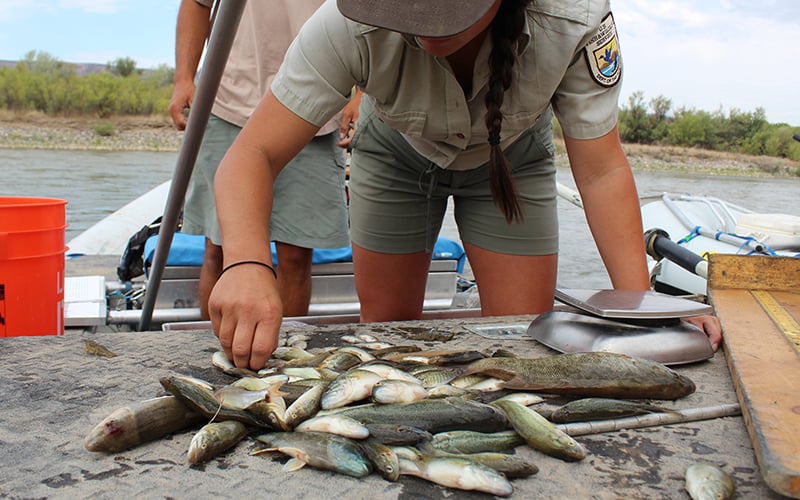Next year, two hallmark endangered species recovery programs, which support hundreds of fish and stream restoration projects in Colorado and four other western states, are up for congressional re-authorization, and water and wildlife officials are gearing up to make sure, even in times of political uncertainty, that the reauthorization gets done.
At stake are two coordinated programs to protect and revive four fish species: The razorback sucker, the Colorado pikeminnow, the bonytail and the humpback chub.
The 1973 Endangered Species Act (ESA) gives the federal government authority to protect these species, which can affect how water is managed and administered. This work is done under the Upper Colorado River Endangered Fish Recovery Program, in place since 1988, and the San Juan River Basin Recovery Implementation Program, in place since 1992. They are set to expire in September of 2023 if Congress does not approve their extensions.
Getting these programs reauthorized is a top priority for Colorado, said Kelly Romero-Heaney, assistant director for water policy at the Colorado Department of Natural Resources. “It’s a really important program for the environment but also for our water users,” she said. (Editor’s note: Romero-Heaney also serves on the Water Education Colorado Board of Trustees; Fresh Water News is an initiative of Water Education Colorado.)
Should these recovery programs go away, it would mean that 2,500-plus water projects across the Upper Colorado River Basin, including diversions, reservoirs and dams, and more, would have to consult individually with the U.S. Fish and Wildlife Service (USFWS) on the steps necessary for ESA compliance.
“If we can’t operate through a collaborative program like [the recovery programs], then our relationship with the USFWS really just becomes a regulatory one,” Romero-Heaney said.
Under the ESA, if water diversions, projects or actions carried out, funded or authorized by a federal agency jeopardize a threatened or endangered species, the USFWS can require modification of those operations. During permitting, the agency and partners involved in the project consult with the USFWS through what’s known as a “Section 7 consultation” — referring to Section 7 of the ESA — to ensure that the project won’t harm any threatened or endangered species.
But in much of Colorado, during these consults on water projects, rather than developing ways to offset the impacts of each individual water project, state representatives, tribes, conservation groups, and water users band together to work with the USFWS on endangered fish recovery programs that create a blanket offset for numerous projects. There are endangered species recovery programs on the Upper Colorado, the San Juan, and the Platte rivers, and they include measures ranging from streamflow targets, to hatchery work, to non-native fish removal.
“I can’t say enough about the endangered species recovery programs,” said Romero-Heaney, who also serves on the implementation committee for the Upper Colorado River Endangered Fish Recovery Program, which, together with the San Juan River Basin Recovery Implementation Program, provides protection for more than 1,500 water projects in Colorado and another 1,000 projects across the four state Upper Colorado River Basin, which includes Wyoming, Utah, New Mexico, and a corner of Arizona. Without the programs and partnership with the USFWS, each of those projects individually would have to consult with the federal agency to ensure ESA compliance, taking actions — like diverting less water or installing fish screens — to offset their impact on their own.
Plus, without the programs, recovery efforts would be less coordinated with fewer ecological benefits. “We more than comply with the ESA. We set the goal to solve the problem, to recover and delist the species, so we’re doing a lot more than just Section 7, which mitigates the impact of one project,” said Tom Pitts, a consultant who represents water users in both the Upper Colorado River and San Juan recovery programs.
Negotiations for next year’s reauthorization are focused on funding, which has historically come, in part, from power generation revenue on Colorado River reservoirs. Now, with less water in the reservoirs and water levels dropping, that revenue source could be vanishing. The programs are too important to too many people to allow them not to be reauthorized, Pitts said, so the question may not be whether they’ll be reauthorized, but rather how to fund them in the future.
Elizabeth Miller contributed to this report.
Caitlin Coleman is a contributor to Fresh Water News and is editor of Water Education Colorado’s Headwaters Magazine. She can be reached at caitlin@wateredco.org.
An earlier version of this article appeared in the fall edition of Headwaters magazine.
Fresh Water News is an independent, nonpartisan news initiative of Water Education Colorado. WEco is funded by multiple donors. Our editorial policy and donor list can be viewed at wateredco.org.


 Print
Print